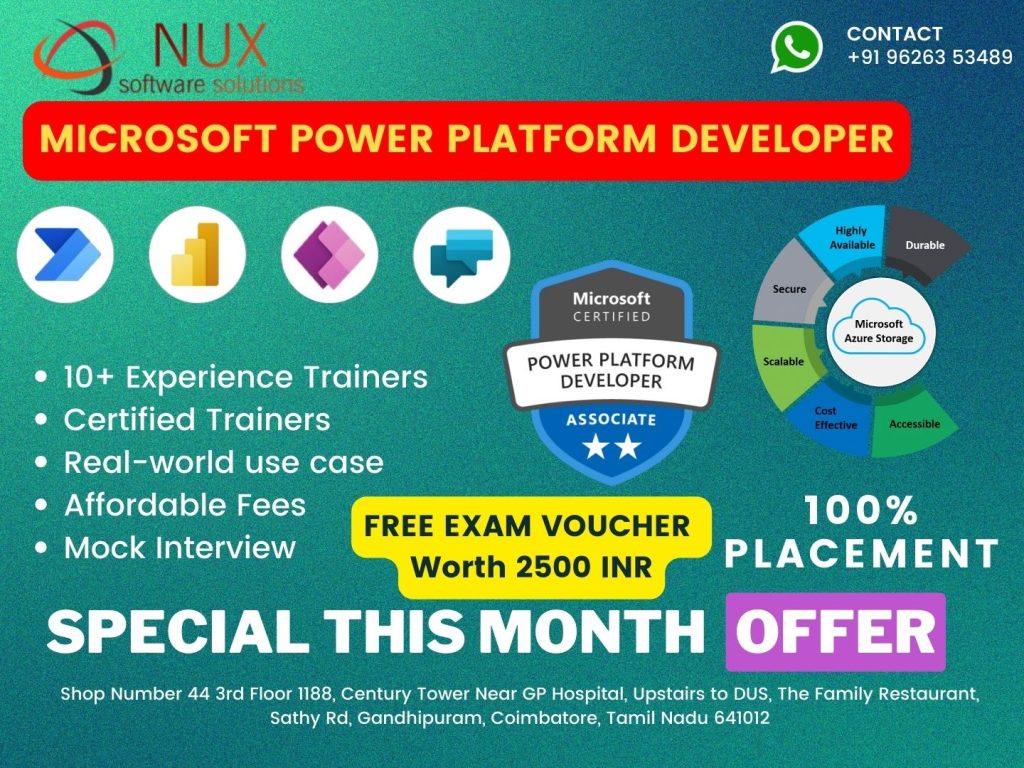Microsoft MS-700 Exam

Course Overview:
The MS-700: Managing Microsoft Teams course is designed to equip IT professionals with the skills to configure, deploy, and manage Microsoft Teams environments effectively. This course will help learners understand the architecture, integration capabilities, security, compliance, and collaboration features within Microsoft Teams, especially relevant to those transitioning from Linux system administration or hybrid infrastructure environments.
Why Choose This Course?
Microsoft Teams has become a foundational communication and collaboration platform for businesses worldwide. As organizations increasingly adopt Microsoft 365, there’s a high demand for skilled professionals who can manage, secure, and support Teams environments. This course is specially designed for IT professionals, including those with a Linux or DevOps background, who want to expand into the Microsoft cloud space.
By training with Linux Training Center in Coimbatore, you gain:
Training from certified and experienced Microsoft 365 professionals
Real-time lab experience simulating enterprise environments
Cross-platform relevance for Linux and Windows professionals
Full alignment with the official MS-700 certification objectives
Ongoing post-training support for exam preparation and job assistance
Why You Should Enroll
This course is ideal for:
Linux and Windows administrators who want to expand into Microsoft 365
IT support staff managing cross-platform collaboration tools
Cloud and DevOps engineers seeking to manage Teams and automate tasks
Professionals preparing for the Microsoft Teams Administrator Associate certification
Job seekers and students looking to add in-demand enterprise collaboration skills to their profile
Whether you’re upskilling for a promotion or pivoting into cloud-based IT roles, this course builds the practical knowledge needed to manage Microsoft Teams at a professional level.
What You Will Learn
By the end of this course, you will be able to:
Microsoft Teams Architecture
Understand how Teams integrates with Microsoft 365 services
Analyze Teams’ core components, licensing, and infrastructure
Planning and Deployment
Prepare your organization for a Teams rollout
Configure Teams policies, settings, and access controls
Teams and Collaboration Management
Create and manage teams, channels, members, roles, and guest access
Use templates and governance best practices for scalable management
Meetings and Calling
Configure Teams meetings, webinars, audio conferencing, and voice services
Manage calling plans, auto attendants, and call queues
Security, Compliance, and Governance
Apply retention policies, eDiscovery, and data loss prevention
Implement safe links, auditing, and identity protection
Automation with PowerShell
Install and use the Microsoft Teams PowerShell module
Automate user provisioning, team creation, and configuration tasks
Monitoring and Troubleshooting
Monitor service health and usage reports
Diagnose and troubleshoot Teams performance and configuration issues
Course Highlights
Hands-on labs with real-world enterprise scenarios
Script-based administration with PowerShell
Hybrid environment focus (Microsoft + Linux/DevOps workflows)
Practice questions and exam preparation for MS-700
Guidance on integrating Teams with other Microsoft 365 services
Take the Next Step Toward Your Career in Cloud Collaboration
Join our Microsoft MS-700 course and gain the practical expertise to deploy, manage, and secure Microsoft Teams for any organization. Whether you’re advancing your current role or preparing for Microsoft certification, this course is your pathway to success in the modern workplace.
Limited seats available. Enroll today to secure your spot.
Microsoft MS-700 Exam Syllabus
Modules
Configure and manage a Teams environment (45-50%)
- Calculate network bandwidth capacity for Teams voice, video, meetings, and Live Events
- Analyze network impact by using Network Planner
- Specify network ports and protocols used by Teams
- Specify optimal network architecture for Teams
- Assess network readiness and connectivity by using the Microsoft Teams Network Assessment Tool and Microsoft 365 network connectivity test tool
- Identify licensing requirements for security and compliance features
- Specify security and compliance alert policies for Teams
- Choose appropriate Teams administrator roles
- Plan and configure Enhanced encryption policies
- Plan and configure threat policies in Microsoft 365 Defender
- Plan and configure retention policies
- Plan and configure sensitivity labels and policies
- Plan and configure data loss prevention (DLP) policies
- Plan Conditional Access for Teams
- Plan and configure information barrier (IB) policies
- Identify appropriate use cases for communication compliance and insider risk management
- Identify licensing requirements for advanced lifecycle management of teams
- Identify where Teams stores content
- Plan and manage update policies, including Public Preview, Office Insider, and Targeted release
- Create and manage policy packages in Teams
- Plan and configure policy assignment for users and groups
- Configure settings for Microsoft 365 group creation
- Configure an expiration policy for Microsoft 365 groups
- Configure a naming policy for Microsoft 365 groups, including blocked words
- Archive, delete, or unarchive one or more teams
- Restore or troubleshoot the deletion of a Microsoft 365 group
- Identify when to use access reviews in Azure AD for members and guests
- Perform operations for Teams by using PowerShell
- Identify licensing requirements for external collaboration
- Configure SharePoint Online and OneDrive external sharing settings
- Configure External access in the Microsoft Teams admin center
- Configure External collaboration settings in Azure AD for guest access
- Configure guest access and sharing in the Microsoft Teams admin center, Microsoft 365 admin center, or Azure Active Directory admin center
- Control guest access to a specific team, including sensitivity labels and Azure AD
- Remove guests from Teams, including from a team or a tenant
- Configure shared channels for external access
- Configure and manage cross-tenant access for B2B direct connect in Azure AD for shared channels
- Identify licensing requirements for Teams Phone and resource accounts
- Identify licensing requirements for Teams devices
- Manage configuration profiles for Teams devices
- Configure Teams Rooms accounts and systems
- Manage device settings and firmware
- Manage Teams device tags
- Provision and configure remote sign-in for new devices
Manage teams, channels, chats, and apps (20-25%)
- Create a team by using the Microsoft Teams admin center, Teams client, or the Teams PowerShell module
- Create a team from an existing Microsoft 365 group, SharePoint site, or team
- Create a team from a template
- Create and manage Teams templates and template policies
- Manage the membership of a team
- Assign and modify user roles in a team
- Manage a team in the Microsoft Teams admin center
- Manage Teams environment settings in the Microsoft Teams admin center
- Configure privacy and sensitivity settings for Teams
- Recommend channel types, including standard, private, and shared
- Add, edit, and remove channels
- Manage Teams channel settings
- Create and manage teams policies for channels
- Manage private and shared channel membership
- Create and manage messaging policies
- Manage Org-wide app settings in the Microsoft Teams admin center
- Create and manage app permission policies
- Create and manage app setup policies
- Manage permissions and consent for apps, including blocking apps
- Recommend appropriate extensibility options, including apps, connectors, tabs, meetings, and messaging extensions
- Manage purchasing of apps in the Teams app store
- Customize the appearance of the Teams app store
- Customize the branded experience of an app
- Upload an app to Teams
Manage meetings and calling (15-20%)
- Recommend meeting types, including live events, webinars, and virtual appointments
- Enable enhanced meeting features for a user by assigning Microsoft Teams Premium licenses
- Configure meeting settings
- Create and manage meeting templates and template policies
- Create and manage meeting policies
- Create and manage conference bridges
- Create and manage audio conferencing policies
- Plan and configure live events settings and policies
- Evaluate PSTN options, including Calling Plan, Direct Routing, Operator Connect, and Teams Phone Mobile
- Add, change, or remove an emergency address for an organization
- Provision and manage phone numbers for users, services, and conferencing bridges
- Assign, change, or remove a phone number for a user or a resource account
- Create and manage resource accounts in the Microsoft Teams admin center
- Manage voice settings and policies for users
- Create and manage voicemail policies
- Configure auto-attendants and call queues
- Create and manage calling policies
Monitor, report on, and troubleshoot Teams (10-15%)
- Monitor and report on voice and meeting quality
- Report on Teams usage, including team activity, app usage, active users, per-meeting metrics, and storage usage
- Monitor and report on the creation and deletion of teams
- Monitor and report on guest access
- Monitor the Microsoft 365 network connectivity test tool
- Manage feedback policies
- Collect client-side logs
- Clear the Teams client cache
- Troubleshoot issues by using self-help diagnostics for Teams
To ensure success in Managing Microsoft Teams certification exam, we recommend authorized training course, practice test and hands-on experience to prepare for Managing Microsoft Teams (MS-700) exam.



